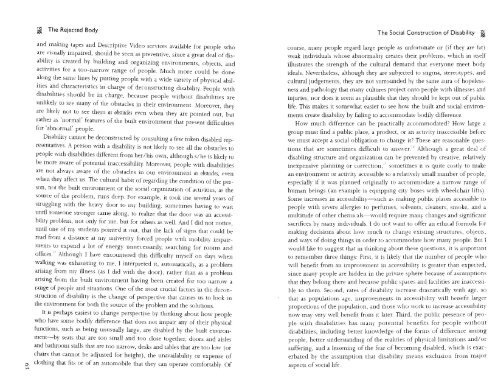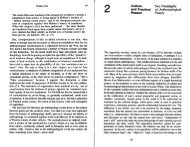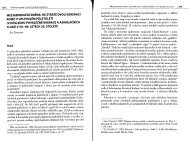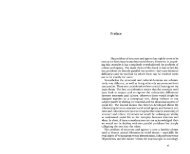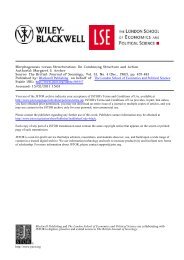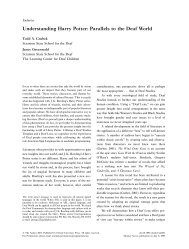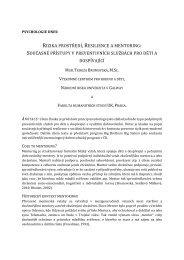The Social Construction of Disability - Moodle
The Social Construction of Disability - Moodle
The Social Construction of Disability - Moodle
Create successful ePaper yourself
Turn your PDF publications into a flip-book with our unique Google optimized e-Paper software.
~ <strong>The</strong> Rejected Bodyand making tapes and Descriptive Video services available for people whoare visually impaired, should be seen as preventive, since a great deal <strong>of</strong> disabilityis created by building and organizing environments, objects, andactivities for a too-narrow range <strong>of</strong> people. Much more could be donealong the same lines by putting people with a wide variety <strong>of</strong> physical abilitiesand characteristics in charge <strong>of</strong> deconstructing disability. People withdisabilities should be in charge, because people without disabilities areunlikely to see many <strong>of</strong> the obstacles in their environment Moreover. theyare likely not to see them as obstacles even when they are painted out, butrather as 'normal' features <strong>of</strong> the built environment that present difficultiesfor 'abnormal' people.<strong>Disability</strong> cannot be deconstructed by consulting a few token disabled representatives.A person with a disability is not likely to see all the obstacles topeople with disabilities different from her/his own, although s/he is likely tobe more aware <strong>of</strong> potential inaccessibility. Moreover, people with disabilitiesare not always aware <strong>of</strong> the obstacles in our environment as obstacles, evenwhen they affect us. <strong>The</strong> cultural habit <strong>of</strong> regarding the condition <strong>of</strong> the person,not the built environment or the social organization <strong>of</strong> activities. as thesource <strong>of</strong> the problem, runs deep. For example, it took me several years <strong>of</strong>struggling with the heavy door to my buildinp. sometimes having to waituntil someone stronger carne along, to realize that the door was an accessibilityproblem, not only for me, but for others as well. And I did not notice,until one <strong>of</strong> my students pointed it out, that the lack <strong>of</strong> signs that could beread from a distance at my university forced people with mobility impairmentsto expend a lot <strong>of</strong> energy unnecessarily, searching for rooms and<strong>of</strong>fices." Although I have encountered this difficulty myself on days whenwalking was exhausting to me, I interpreted it, automatically. as a problemarising from my illness (as I did with the door), rather than as a problemarising from the built environment having been created for too narrow armge <strong>of</strong> people and situations. One <strong>of</strong> the most crucial factors in the deconstruction<strong>of</strong> disability is the change <strong>of</strong> perspective that causes us to look inthe environment for both the source <strong>of</strong> the problem and the solutions.It is perhaps easiest to change perspective by thinking about how peoplewho have some bodily difference that does not impair my <strong>of</strong> their physicalfunctions, such as being unusually large, are disabled by the built environment-byseats that are too small and too close together, doors and aislesand bathroom stalls that are too narrow, desks and tables that are too low (orchairs that cannot be adjusted for height), the unavailability or expense <strong>of</strong>0. clothing that fits or <strong>of</strong> an automobile that they can operate comfortably. Of'~<strong>The</strong> <strong>Social</strong> <strong>Construction</strong> <strong>of</strong> <strong>Disability</strong> ~. ~~~course, many people regard large people as unfortunate or (if they are fat)weak individuals whose abnormality creates their prohlems, which in itselfillustrates the strength <strong>of</strong> the cultural demand that everyone meet bodyideals. Nevertheless, although they are subjected to stigma, stereotypes, andcultural judgements, they are not surrounded by the same aura <strong>of</strong> hopelessnessand pathology that many cultures project onto people with illnesses andinjuries, nor does it seem as plausible that they should be kept out <strong>of</strong> publiclife. This makes it somewhat easier to see how the built and social environmentscreate disability by failing to accommodate bodily difference.How much difference can be practically accommodated? How large agroup must find a public place, a product, or an activity inaccessible beforewe must accept a social obligation to change it? <strong>The</strong>se are reasonable questionsthat are sometimes difficult to answer. I; Although a great deal <strong>of</strong>disabling structure and organization can be prevented by creative, relativelyinexpensive planning or correction," sometimes it is quite costly to makean environment or activity accessible to a relatively small number <strong>of</strong> people,especially if it was planned originally to accommodate a narrow range <strong>of</strong>human beings (an example is equipping city buses with wheelchair lifts).Some increases in accessibiliry-e-such as making public places accessible topeople with severe allergies to perfumes, solvents, cleaners, smoke, and amultitude <strong>of</strong> other chemicals-would require many changes and significantsacrifices by many individuals. I do not want to <strong>of</strong>fer an ethical formula formaking decisions about how much to change existing structures, objects,and ways <strong>of</strong> doing things in order to accommodate how many people. But Iwould like to suggest that in thinking about these questions, it is importantto remember three things: First, it is likely that the number <strong>of</strong> people whowill benefit from an Improvement in accessibility is greater than expected.since many people are hidden in the private sphere because <strong>of</strong> assumpnonsthat they belong there and because public spaces and facilities are inaccessibleto them. Second, rates <strong>of</strong> disability increase dramatically with age, sothat as populations age, improvements in accessibility will benefit largerproportions <strong>of</strong> the population, and those who work to increase accessibilitynow may very well benefit from it later. Third, the public presence <strong>of</strong> peoplewith disabilities has many potential benefits for people withoutdisabilities, including better knowledge <strong>of</strong> the forms <strong>of</strong> difference amongpeople, better understanding <strong>of</strong> the realities <strong>of</strong> physical limitations and/orsuffering, and a lessening <strong>of</strong> the fear <strong>of</strong> becoming disabled, which is exacerbatedby the assumption that disability means exclusion from majoraspects <strong>of</strong> social life


